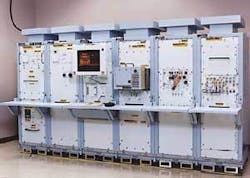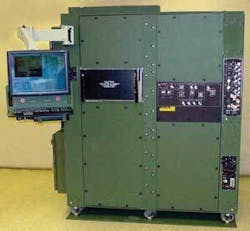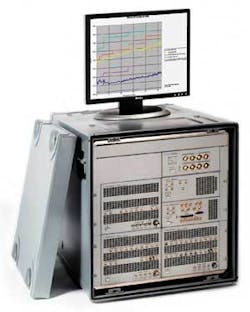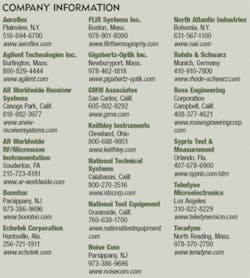Federal programs, industry consortia, and engineers advance RF and microwave technologies to ensure their accuracy and reliability.
By Courtney E. Howard
Doubtless, it is important to ensure the accuracy, availability, and reliability of virtually all electronic systems employed in military, avionics, and aerospace applications, yet few are more critical than radio-frequency (RF) and microwave solutions.
“You are flying above enemy lines when you suddenly receive a warning signal from your radar about a high-velocity object coming toward you. Wouldn’t you like to know that the radar information is accurate? That is the whole point of defense applications testing,” says Guillaume De Giovanni, director of business development at Aeroflex Inc. in Plainview, N.Y. “Now about space: how could you fix the probe you just sent to Mars if it went down? Well, you can’t. That is why you want to test all space equipment to ensure availability and reliability.”
Test and measurement lies at the heart of much of today’s military and aerospace research and development programs. RF and microwave devices vary widely in form and function, ranging from one cable to a complete radar or communications system. Users depend on these systems to provide accurate, repeatable measurements throughout the frequency spectrum.
The U.S. Navy is initiating eCASS, a program designed to modernize test and measurement systems, such as the one above, based on its Consolidated Automated Support System (CASS), which debuted as the largest automated test support program and the first recognized DOD standard test system nearly 20 years ago.
“When we depend on a machine, we need it to produce accurate, reliable, and consistent statements,” adds De Giovanni. “Accuracy and reliability can only be fully guaranteed by test and measurement equipment.”
Modernization efforts
A heightened focus on military test and measurement began nearly two decades ago with the Naval Air Systems Command’s (NAVAIR’s) debut of the Consolidated Automated Support System (CASS). Considered the largest automated test support program and the first recognized U.S. Department of Defense (DOD) standard test system, CASS provides general-purpose analog and digital test capabilities, RF receiver stimulus and measurement in the UHF frequencies and higher, and electro-optical testing.
Today, officials in NAVAIR’s Program Management Activity office for Aviation Support Equipment at Patuxent River Naval Air Station, Md., are starting a CASS modernization program called eCASS. Set to begin production in 2008, eCASS targets updating relatively old test equipment, thwarting system obsolescence, and upgrading test capabilities to support future weapon systems.
Similarly, the DOD’s Automatic Test Systems Management Board prompted the U.S. Navy to devise a new equipment testing strategy. Navy leaders then chartered the Next Generation Automatic Test Systems integrated project team (NxTest) to develop next-generation automatic test equipment. Its goal is the design and production of an open-architecture system of modular hardware and flexible software to test and maintain combat systems across all branches of the U.S. military. The DOD also launched the Agile Rapid Global Combat Support system, an advance concept technology demonstration project, to bring about the development of a single tester that takes advantage of all test technologies.
These programs might seem disparate-especially considering they launched at different times for different reasons-yet they are working toward the same goal: an open test and measurement system flexible enough not only for different users to evaluate a wide array of combat systems, but also to offer future viability through the accommodation of coming technologies. In the world of RF and microwave in particular, this quest may be as complex as the systems themselves.
The nature of the beast
RF and microwave solutions are largely high-performance, high-end systems; they need to be, given they must tap into high frequencies. Devices designed to analyze this type of equipment, in turn, must push technology and the state of the art. As a result, pieces of RF and microwave test equipment for frequencies higher than 1 GHz tend to be fairly expensive compared to those in the subgigahertz realm. Despite their complexity, however, RF and microwave systems do not require more testing than other electronic solutions.
“It is not because your work is related to microwave applications that you always have to test,” De Giovanni explains. “It is the military and aerospace environment that generates this need. Mil/aero applications, almost regardless of cost, need the ultimate performance; you must achieve a performance that no one else can.”
The U.S. Navy followed its CASS program with the Reconfigurable-Transportable CASS (RT-CASS), shown above, which turns out to be a stepping stone en route to eCASS, the latest initiative targeted at updating test and measurement systems.
Those involved in the design, development, and quality control of RF and microwave components test their company’s components diligently, given that users of RF and microwave systems sometimes must put their lives on the line.
As the director of engineering at Teledyne Relays in Hawthorne, Calif., Minh Tran uses high-end test and measurement equipment-including a network analyzer, calibration kits, and calibration verification kits-to characterize the company’s RF and microwave components and confirm their accuracy. Teledyne Relays makes switches for RF and microwave applications and instrumentation.
“We test to ensure that the products meet the RF characteristics, such as insertion loss, isolation, and efficient loss repeatability, or how well a signal can maintain its integrity throughout its life,” Tran says. “For RF and microwave products, insertion loss-how much loss occurs when a signal is going through a relay-is probably the most critical parameter. You want to have as low a loss as possible; the lower the loss is, the better you can maintain the integrity of the signal going through it.”
Ralph Kimball, a chief technologist at the Mercury Computer Systems Echotek product group in Huntsville, Ala., is a user of RF and microwave test equipment who is concerned with isolation, loss, and bandwidth issues. Echotek produces high-speed digital receivers and transmitters and includes an RF group that builds radios, transmitters, and receivers through microwave.
A rack of today’s synthetic instruments, such as the Agilent solution shown above, is capable of replacing multiple racks of legacy test and measurement systems with hardware building blocks and powerful software applications.
“One of the big challenges is phase-noise measurement,” Kimball says. “In systems that are being used for radio and commo (communication), everybody is worried about coherence and doing beam forming with multiple radios. Phase noise is very important in order to measure the angles of arrival and to do beam steering and direction finding. In some cases, beam forming improves the signal-to-noise ratio; in other cases, it takes care of lossy paths or multiple transit-type problems.”
The presence of phase noise adversely affects one’s ability to locate the signal source. Also of concern in the digital world, phase noise can cause a user to misconstrue a small signal that is near a large source of interference, or to pick up a spur instead of the correct signal.
Amplitude accuracy is another important consideration when testing RF and microwave equipment. Variations in amplitude affect the ability to measure the angle of arrival, degrade the signal noise, and impede beam forming.
Consistent calibration
Before testing RF and microwave devices to ensure their accuracy, it is important to confirm the effectiveness of the test and measurement equipment. To this end, careful calibration is key.
“All the measurements that you make need to be traceable to the National Institute of Standards and Technology (NIST)-the claim to fame for test and measurement,” says Frank Angelo, system products manager at the Agilent Technologies electronics measurements group in Santa Rosa, Calif. “To do that repeatably and reliably, it requires a fair amount of investment in measurement science. If a system is not calibrated regularly, you have the possibility of not being traceable to NIST and of making erroneous measurements.”
This need to calibrate test and measurement equipment is, according to some, only compounded by the growing use of standard commercial components.
“Commercial off-the-shelf (COTS) solutions are often much more cost effective than their specifically designed counterparts,” notes De Giovanni. “But, as COTS specifications might not always match the application requirements, the need of testing to demonstrate the compatibility of these components when they are utilized beyond their standard limits increases.”
De Giovanni is part of the Phase Noise division of Aeroflex, a company that produces test and measurement solutions for aerospace, defense, and broadband communications applications. De Giovanni says believes in confirming the accuracy of test and measurement systems via several performance checks over the life of the equipment.
“Checking performance is a must at the design stage, but it is also needed during the manufacturing process,” De Giovanni points out. “After the device is in service, depending on its recommended calibration cycle, it may need to be measured every two years or every hour. The more challenging the application is in terms of accuracy and repeatability, the more time you will need to operate your device and the more time spent verifying that what you are doing is compliant. Ensuring high performance for devices implies high performance on the test equipment too.”
Technology evolution, architectural revolution
RF and microwave test and measurement tends to be a high-performance niche, and one that is growing quickly. A renewed interest and focus on test and measurement technology, as well as on such RF and microwave applications as communications and radar, is breathing new life into an industry segment once considered to be slow moving. In fact, myriad test and measurement vendors are investing heavily in research and development and taking part in industry forums, consortia, and government programs, with the goal of furthering test and measurement technologies.
“Microwave technology is becoming more highly integrated, allowing it to be smaller, cheaper, and higher performance at the same time,” Agilent’s Angelo says. “These levels of integration are due to sophisticated manufacturing and design technologies that allow more capability to be put on a substrate. Analogous to what was done on an integrated circuit many years ago, it is being used more and more in the microwave realm.”
High-speed digital is growing into the RF and microwave market, and digital equipment is well suited to applications throughout the aerospace and defense sectors. Digital-to-analog converters and analog-to-digital converters are moving into the range of one gigahertz and beyond, which brings about a dramatic change in the way that experts design instrumentation, Angelo notes.
“The evolution of technology has created the opportunity for a revolutionary change in architectural composition of test and measurement,” Angelo states. “With the capabilities in microwave and particularly high-speed digital, the ability to synthesize instrumentation largely residing in a digital and software domain is now opened up, where in past years it was a dream or a desire.”
This synthesis is blurring the line between typical families of test and measurement equipment, including digital voltmeters, oscilloscopes, and spectrum analyzers, Angelo finds. The architectural innovation is a substantial leap forward in the test and measurement sector, and one that is expected to predominate in the coming years.
“Most instrument types could be synthesized from several basic building blocks of high-performance subsections,” Angelo says. “We can synthesize each to be comfortable to the past paradigm that we’re used to, but the actual measurement science and measurement processing can go way beyond what we have been used to for the past several decades.”
Synthetic instrumentation
Technological and architectural advancements, as well as programs such as CASS and NxTest, all appear to be moving in the same general direction-toward synthetic instrumentation. Perhaps the biggest concept to hit test and measurement in a long time, the synthetic instrument (SI) architecture is modular, scalable, and open. Synthetic instruments include hardware modules and software components that can be reconfigured and recombined readily to fulfill the test and measurement needs of various electronic systems, military branches, and missions.
“One of the main innovations in RF and microwave testing is the extensive use of software,” says De Giovanni. “Processing power is coming to the rescue of physical limitations. Test system architectures have gone from ‘virtual instrumentation’ to ‘synthetic instrumentation,’ which creates objects by combining real hardware bricks and processing software.”
SI marks a move from racks of proprietary application-specific devices to one modular open system that enables interoperability among software and hardware from several vendors, and among all branches and ranks of the military. At the same time, SI reduces the need for costly and bulky keyboards and monitors, and enables the replacement of racks of legacy instruments with one compact device.
RF and microwave systems and their respective test and measurement equipment, will continue to reach higher and higher frequencies, accompanied by a reduction in physical size and price. Vendors of RF and microwave components, such as Teledyne Relays and Echotek, already are seeing that trend.
“RF and microwave systems can only go up in frequency, and vendors are responding to the demand by designing equipment to test at higher frequencies,” says Teledyne Relays’s Tran. “That’s the future: high-frequency signal products that need to be tested.”
“Everything is going higher in frequency,” notes Echotek’s Kimball. “They are always going to higher bandwidths, which translates to wider frequency demands. They are crowding the spectrum-competing technologies want to use the bandwidth. As frequency increases physical size decreases, which is another reason to do it-antennas and other components become smaller. Test and measurement systems will have to keep pace with the technology. RF and microwave system manufacturers follow the technology of the test and measurement vendors, because the products do. The test equipment becomes something of a driving function as to what you can do; you can’t debug a design if you can’t look at the signal.”
At the same time, the advancement and adoption of digital technologies will continue to achieve steady growth rates, at essentially a Moore’s Law pace, in the years and decades to come.
“Everybody is trying to push as close to the antenna as possible, because the analog front ends tend to drift with time and temperature,” Kimball says. “The quicker you can get a signal digitized, the quicker you become immune to environmental conditions; it makes a lot of sense to go digital as soon as possible. Another reason is to have total flexibility. You can change waveforms, pulses, anything you want and you’re not changing hardware, but a program and an FPGA [field-programmable gate array].”
Vendors, systems integrators, and end users are increasingly comingling digital and analog technologies, components, and devices-and with favorable results. It is evident that digital is starting to blend with RF and microwave, further contributing to the revolution in instrumentation architecture.
“Today’s tools are very robust, but they are also limited,” Angelo says. “As this future technology unfolds, those gaps will be filled in and test and measurement suppliers will be able to test things quickly, more thoroughly, and advance technologies more rapidly. Yet, many years of evolution are possible here, and at high rates. This trend in high-speed digital and integrated microwave and architectural evolution has many years to play out.”
A bright future for SI and LXI
The U.S. Navy’s eCASS test and measurement program, short for enhanced Consolidated Automated Support System, is a prime candidate for synthetic instrument (SI) technology, say officials of the U.S. Naval Air Systems Command (NAVAIR) at Patuxent River Naval Air Station, Md.,
Some high-level NAVAIR executives and test and measurement system developers are hedging their bets that synthetic instruments will serve as the core of the eCASS program. Among them is Bob Rennard-president of the LXI (LAN-based eXtension for Instrumentation) Consortium (www.lxistandard.org) and program manager at Agilent Technologies-who favors SI’s efficient asset reuse profile.
The LXI Consortium, a not-for-profit corporation founded by Agilent Technologies and VXI Technology Inc., promotes the development and industry adoption of the LXI Standard-an open standard for the test, measurement, and data acquisition industry.
The LXI instrumentation platform is based on Ethernet networking technology, and designed to meet the needs of engineers who deliver electronics to the aerospace/defense, automotive, industrial, medical, and consumer electronics markets.
Proponents are positioning LXI as the successor to the general-purpose interface bus (GPIB), the dominant test interface and one that has been used for roughly three decades. By today’s standards, GPIB is considered to be slow, bulky, and expensive. LXI, by contrast, takes advantage of the local area network (LAN) and Ethernet, both of which are readily and freely available on modern PCs; and increasingly, makers of test equipment are integrating Ethernet into new products.
“We saw a lot of vendors putting Ethernet on test equipment, and we realized that we had better come up with a consistent way of doing it if we are going to be successful,” Rennard says. “If everybody implemented Ethernet independently, the chances of it working together were slim. I, for one, envisioned that it would result in frustrated customers and calls into our support lines.”
Rennard and his colleagues in the LXI Consortium talked to test vendors and systems integrators to gauge their test needs. In summer 2004, the LXI Consortium proposed the LXI specification, which recommends how to implement Ethernet for instrumentation in a consistent manner.
“We all started using PCs in the early IBM days, and you used a big, fat serial cable or parallel cable to connect your PC to your printer,” recalls Rennard. “That was before the days of networking; now you just connect your PC to a CAT-5 cable (category 5 shielded cable for gigabit LAN or better) and run to a network printer or connect to the Ethernet. It has changed the way we work in the office. I firmly believe, as do the members of the LXI consortium, that the same thing is going to happen with test and measurement. We’re going to go from the big, fat parallel cable like we’re used to on a printer, which is the equivalent of GPIB, and we’re going to migrate to a network- or Ethernet-centric use model. It will fundamentally change the way test systems are architected.”
The move to LXI does not simply involve replacing GPIB cables with CAT-5 cables, although Rennard admits that it can be done. Members of the LXI Consortium endeavored beyond connectivity issues, infusing the standard with Ethernet and networking capabilities.
Members of the consortium expect LXI to exceed GPIB. Given the low cost, availability, simplicity, and speed of Ethernet, LXI holds promise. Among its other benefits is a web interface through which users can configure test systems, monitor assets, and, in the case of military customers who require traceable test, track models and serial numbers.
Through the addition of the IEEE-88 precision timing protocol, LXI enables integrators to time-stamp data or commands, drive tests in a time-sequenced manner, or use it to time optimize. Moreover, a unified trigger model was devised.
“Most test systems have a variety of different triggers that all behave differently, and the programmer has to decide which one he wants to use,” Rennard says. “With LXI, it’s a unified trigger model that allows the programmer to use hardware triggers, LAN triggers, or time-based triggers. The programmer can program it one way, then change a global variable and have it work another way.”
The LXI Consortium has upgraded the specification to release 1.1. In addition to clarifications on the wording of the original spec, version 1.1 boasts Section 15, a hybrid systems section that discusses the potential of updating legacy equipment to LXI, such as through bridges, adapters, and other hybrid systems interface devices.
“There’s an awful lot of equipment out there that’s not LXI,” Rennard notes. “It’s going to be a while before every piece of equipment available in the catalogs is LXI compliant, and this equipment lasts an awful long time. One of our objectives in building the LXI spec is to ease the transition for integrators into LXI.”
Members of the LXI Consortium anticipate the introduction of a multivendor, real-world test system demonstration during September’s Autotestcon in Anaheim, Calif. The test system incorporates a variety of instruments and software environments from a multitude of vendors. It is intended to show the audience how LXI enables such a system to be assembled, as well as illustrate LXI’s features and benefits.





